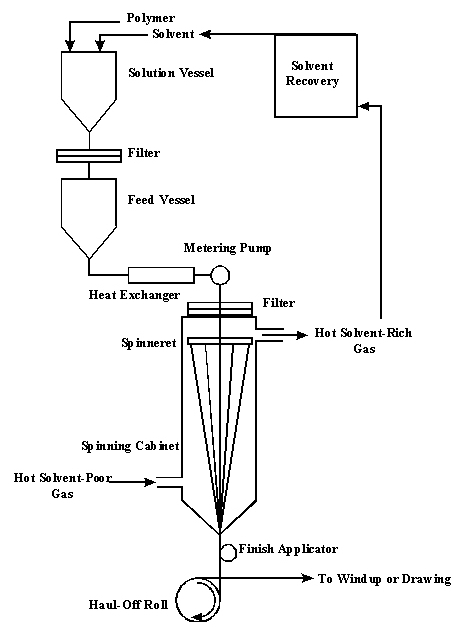
The polymer is dissolved in a solvent (3-5x that
of the polymer) in the solution vessel and the insoluble material is filtered
out. The insoluble material may be foreign matter, cross-linked material
or polymer that has not dissolved. A higher viscosity is needed for
dry spinning than for wet spinning in order to achieve the necessary polymer
concentration needed for spinning. The polymer solution is then taken
from the feed vessel and heated by the heat exchanger to a temperature
above the boiling point of the solvent. The solution is then re-filtered
and extruded trough a spinneret into the spinning cabinet. The number
of holes in the spinneret typically does not exceed 2000. The spinning
cabinet has pre-heated gas (air, nitrogen, carbon dioxide, superheated
steam, or solvent vapor) entering at the bottom of the spinning cabinet.
The gas flows around the spun fibers and the solvent is rapidly removed
from the fiber and the solvent rich gas exits out of the top.
The typical height of a spinning cabinet is 3-10 m tall and the fibers
can be wound up at speeds up to 1000 m/min. The fibers exiting the
solvent cabinet can have 1-50% residual solvent which acts as a plasticizer
so that the fibers can be drawn. The residual solvent is removed
via washing. Dry spun fibers typically have lower void content than
wet spun fibers. However, due to their higher density, they have
decreased dyeability. Also, fibers can be made so that they have
microvoids in them for sizing or other post-spinning modifications.
A table of several dry-spinning systems
in this table.
Ref:
Kroschwitz, Jacqueline I. Encyclopedia of Polymer
Science and Engineering. Second Edition, Vol. 6. John Wiley & Sons.
New York. 1986 pp. 812-815.